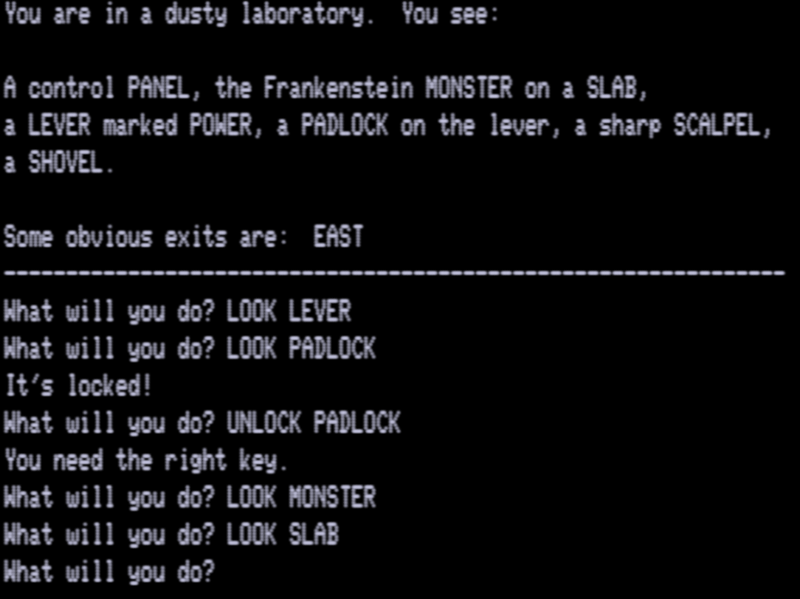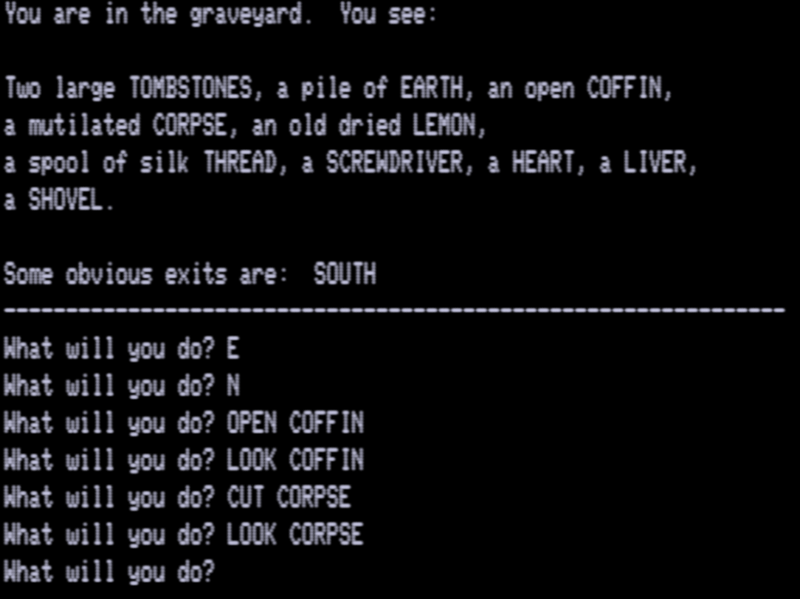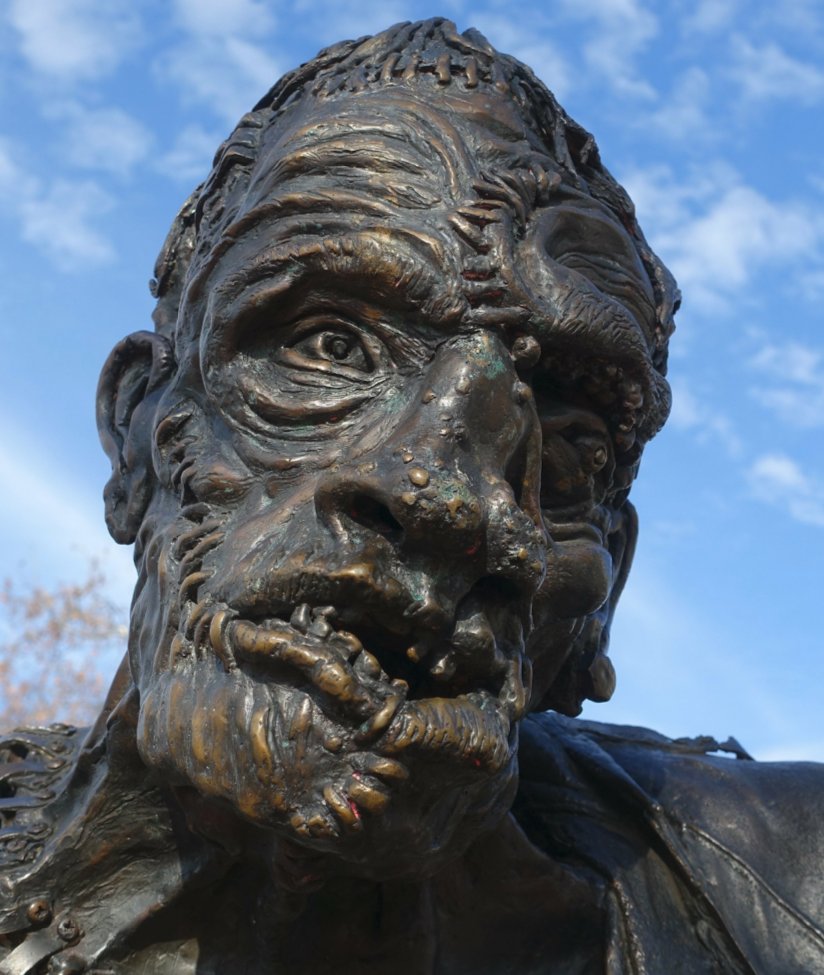Frankenstein Adventure is yet another TRS-80 game in BASIC, and was released in the October 1981 edition of CLOAD. (This was the same “magazine on tape” that had CIA Adventure.)

The reason I have the date listed as 1980 to 1981 is that, rather unusually for a simple BASIC game from this era, there is an extensive interview with the author, John R. Olsen Jr. from Oregon (not to be confused with John R. Olson from Kansas who was working at the same time).
I decided that I was going to write an adventure game. But I had no idea of how to go about it. There were no adventure authoring languages like Visionary at that time. My only choice was to write in the BASIC language. And that meant that I had to write everything: the parser, the input routines, the output routines, as well as the movement and other logic. But I had a pretty good knowledge of BASIC and so undaunted I began writing my first adventure during my Christmas vacation of 1980. The plot of my inaugural adventure was taken from the old horror movies. Its working title was ‘Frankenstein Adventure’. The plot had you (the player) discovering you were the long lost relative of Dr. Frankenstein. As his only heir, you had inherited his mansion. When you arrived, you found a letter from him telling you that he wanted you to complete his creature and bring it to life.
As the quote above implies, you’re not tasked with looting treasures or defeating evil. You are here to create life.

So far I’ve mostly explored. The map is fairly small; there’s a cemetery, a bog, and the house; other than the typical kitchen and dining room the house has a master bedroom with a “four poster BED” and “a PAINTING” of Victor Frankenstein.
There’s also a library, which (perhaps inevitably) had a secret passageway, leading to a laboratory.

My most immediate obstacle to fulfilling Dr. Frankenstein’s dying wish is the padlock on the power level, but I’m guessing that’s not the only hitch; I suspect the monster itself will need some work, but I don’t know with what yet. What I’m getting stalled on is some quicksand…

…and a wolf, who blocks my way back in the house after I dig up a coffin with a corpse.

I have access to a CANDLE, MATCHES, a SCALPEL, a CROWBAR, an old LEMON, some silk THREAD, a SHOVEL, and a SCREWDRIVER. It’s possible I’m still missing an ordinary secret in the house so I won’t call this comprehensive.
With a simple treasure-hunt TRS-80 game I likely would have dived into hints or source code already, but the premise is compelling enough I’m giving the game a little more effort before I throw in the towel. I like how the protagonist’s quest is not framed as good or evil, but just fulfilling a mission as Frankenstein’s last living relative.
The different accidents of life are not so changeable as the feelings of human nature. I had worked hard for nearly two years, for the sole purpose of infusing life into an inanimate body. For this I had deprived myself of rest and health. I had desired it with an ardour that far exceeded moderation; but now that I had finished, the beauty of the dream vanished, and breathless horror and disgust filled my heart.
— From Frankenstein by Mary Shelley
In the original Frankenstein, Victor abandons his “monster” as soon as he creates it; the monster doesn’t really get into murder until he finds out the circumstances of his creation, and plans revenge.
More modern takes have varied, but we’re jumping ahead a bit in the plot–

Before I made any progress on the real story, I was fussing about with all my objects, and discovered BURN worked as a verb on things other than just matches and candles. Dutifully testing out every item in my inventory, I found a secret message:

I also knew the painting of Victor I found last time was “screwed to the wall” so I just needed to get a screwdriver over to the painting to check it out, but I was blocked (as I left off last time) by a wolf.
The wolf had previously emerged when I had unearthed a coffin and a corpse.
After trying to fight off the wolf with little success, I went back to the CORPSE and applied my SCALPEL. This got me a mutilated CORPSE, which had a HEART and LIVER.

Grisly! I took the LIVER over to the wolf and it gobbled it down and ran away. Then I went back to the painting and unscrewed it, and applied the previously mentioned combination. This got me a DIARY and a MAP.

…I guess maybe I’ll find a liver somewhere else? Or did I make a mistake?
Plowing ahead, I took the map over to the bog where I previously was falling into quicksand and did FOLLOW MAP. This led me to an old mill with a crypt beneath.

The URN incidentally has ashes but you can POUR URN to also find gold ELECTRODES (as mentioned in the diary). The crypt had a passage leading back to the graveyard, but the wolf was back, and this time there was no liver to feed him. I did, however, have a fancy cane.

Now comes the most interesting dilemma of the game. I was able to return the HEART over to the monster back in the lab, but I had no liver because the wolf ate it. Except now the wolf is dead and in the form of a man… so maybe…

…is that the same liver? (I think at a code level it is, but at a plot level it’s the man’s original liver we cut out.)
With liver in hand, some working with needle and thread, and attaching the gold electrodes from the urn, I was able to come close to bringing life. I just needed to pull the lever. I fully expected a “you win” message, but:

Ah, of course. This is the kind of monster that comes out swinging right away. It chases you around which strongly suggested the solution was geographical. Restoring my game, grabbing the map I used last time to get by the quicksand, I tried pulling the lever again, and escaped to safety.

In the end, no progress was made: while we finished Victor Frankenstein’s wish, we then undid the monster we created just as quickly.
Many games from this era use the tropes of horror, but far fewer have really been horror. That is, various “monsters” have often been interchangeable with fantasy — a mummy might as well be an orc, a ghost might as well be a goblin. Fully-fledged horror shows people in desperate in tragic circumstances doing desperate and tragic things, and I think Frankenstein Adventure qualifies with the, ah, creative use of corpses. I really did have a moment I was stunned when I realized how I could get a second liver. The gameplay finesse of having seen one that gets “used up” — bringing up the specter of softlocks, yet not being one — made the moment more effective.
…
Audible has recently put up some of their material for free (as in actually free, not a free trial). This includes an absolutely stellar reading of Frankenstein by the actor Dan Stevens (from Downton Abbey); it runs for 8 1/2 hours and if you’re looking for distraction I highly recommend it.
If you’re keen on playing Frankenstein Adventure itself, there’s a version you can play online. The display of the online version is slightly glitchy but it still works.
While I polished off the TRS-80 game of this game already, I was poking at John Olsen’s later port (that he titled Frankenstein’s Legacy) and discovered a feature in the z-code version (made by William Stott) I don’t recall ever seeing in any other adventure game.
First, just to note, all the ports generally do is re-format the game’s text to seem more like a more modern text adventure, as opposed to TRS-80 minimalism.
Dirt path
You are on a dirt path. There is an old, rundown mansion to the north, a swamp in the distance to the east, and to the west is an overgrown cemetery.
Compare with:

Honestly, I think I like the original more? The effect is akin to trying to scale up an old 8-bit game into modern graphics but leaving behind jagged edges.
See also this review from SPAG:
FRANKENSTEIN’S LEGACY’s lack of graphic description is at times comic also. If you order the game to cut open a dead body, you are told “OK.” That’s it, just “OK.”
This event is fine in the TRS-80 version — the appearance of the mutilated corpse in the object list is startling, and the main text is essentially an acknowledgment rather than any kind of atmosphere building. Without the two-window setup, all that’s left is the “OK”.
Now, the new feature.
For fun (and to see how it works), I’ve also implemented a ‘bones file’ (as outlined in ex137 of DM4) to generate the ghosts of the previous 10 player characters killed in the game. This is set ‘off’ by default. To switch on the ghosts, type GHOSTS ON (or HAUNT) near the start of the game.
DM4 is the Designer’s Manual 4 for Inform, the language used to make the port. I reckon someone else must have borrowed this idea since it’s direct from the manual, but I don’t recall ever seeing it re-used — anyone?
When you die in the game, you leave behind a ghost where you died.
>E
Edge of a swamp
You are on the edge of a swamp. There are the distant ruins of an old mill further to the east.
You can see a faint ghost, a sign in the grass and a crowbar here.
>EXAMINE GHOST
The ghost stares at you mournfully. Someone must have died near here once, long ago.
If you die multiple times (quite reasonable to happen on the quicksand and the wolf while you’re solving them) there are multiple ghosts, one for each death. I’ve seen this in puzzle games, RPGs, and even in a multiplayer shooter, but never in adventure games.















